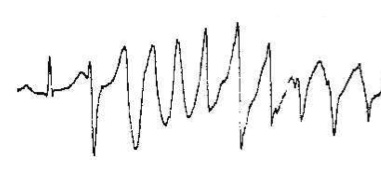Fibrilación ventricular idiopática
Palabras clave:
muerte súbita, fibrilación ventricular idiopática, cardioversor-desfibrilador automático implantable, estimulación eléctrica, sudden death, idiopathic ventricular fibrillation, defibrillator, electrical stimulationResumen
RESUMEN
La fibrilación ventricular idiopática se presenta en sujetos jóvenes, la muerte súbita solo se recupera en el 5% de los casos y las víctimas no suelen ser identificables antes del evento. Los objetivos fueron: caracterizar estos sujetos y conocer su evolución intervenida. El estudio se realizó durante un período de 10 años, comprendió 33 pacientes sin cardiopatía estructural demostrable (la causa de la muerte fue la fibrilación ventricular): 22 hombres y 11 mujeres, edad promedio 39 años. Se excluyeron otras causas de muerte súbita. Se implantó cardioversor-desfibrilador a 30 de ellos (3 lo rechazaron), con seguimiento periódico. Los signos eléctricos premonitorios aparecieron en el 69,7% (los más frecuentes: las extrasístoles ventriculares y las anomalías de la onda T), que permiten estratificar riesgo por grupos pero no son igualmente útiles para el riesgo individual. Las recurrencias de fibrilación ventricular se presentaron en el 81,8% (tormenta eléctrica en 4 pacientes), lo cual obligó a tomar prontas medidas terapéuticas; en ocasiones las arritmias se autolimitaron y sólo se reprodujeron en 3 de las 20 estimulaciones eléctricas practicadas. El uso de fármacos antiarrítmicos fue necesario en: la tormenta eléctrica, las recidivas frecuentes, los eventos supraventriculares concomitantes y los 3 casos que rechazaron el dispositivo. Una vez tomadas las medidas terapéuticas, no hubo fallecidos en la serie. Las recidivas son frecuentes, la estratificación de riesgo individual de arritmias malignas es muy difícil, con pobre inducibilidad de las mismas durante la estimulación.
Palabras clave: muerte súbita; fibrilación ventricular idiopática; cardioversor-desfibrilador automático implantable; estimulación eléctrica
ABSTRACT
Idiopathic ventricular fibrillation is associated with a high risk of sudden cardiac death in young and otherwise healthy adults. The overall survival rate of patients with cardiac arrest is low, estimated to be 5% and victims can not be identified before events. The aims of the study were: characterize these patients and subsequent follow-up after therapeutic intervention. Thirty three patients without known heart disease (22 men, 11 women; mean age 39 years) were studied after being resuscitated from recurrent episodes of idiopathic ventricular fibrillation; 30 had received a defibrillator (3 refused it). Other causes of sudden death were excluded. 69,7% of cases had premonitory electric signs (most frequents: ventricular premature complexes and T wave anomalies). These signs allow group stratification but are not equally useful for individual risk. Ventricular fibrillation recurrences occurred in 81,8% (electric storms occurred in four patients), sometimes the arrhythmias were autolimited and only three of twenty were inducible at electrical stimulation. Antiarrhythmic drugs were required in: electric storms, recurrences of ventricular arrhythmia, supraventricular events and in three patients that refused the defibrillator. No deaths were reported during follow-up. Recurrences are frequents and individual risk stratification of malignant arrhythmias is very difficult, with low inducibility of them during electrophysiological testing.
Key words: sudden death, idiopathic ventricular fibrillation, defibrillator, electrical stimulation
Descargas

Publicado
Cómo citar
Número
Sección
Licencia
Aquellos autores/as que tengan publicaciones con esta revista, aceptan los términos siguientes:- Los autores/as conservarán sus derechos de autor y garantizarán a la revista el derecho de primera publicación de su obra, el cuál estará simultáneamente sujeto a la Attribution-NonCommercial 4.0 Internacional (CC BY-NC 4.0) que permite a terceros compartir la obra siempre que se indique su autor y su primera publicación esta revista. o admite fines comerciales. Permite copiar, distribuir e incluir el artículo en un trabajo colectivo (por ejemplo, una antología), siempre y cuando no exista una finalidad comercial, no se altere ni modifique el artículo y se cite apropiadamente el trabajo original. El Comité Editorial se reserva el derecho de introducir modificaciones de estilo y/o acotar los textos que lo precisen, comprometiéndose a respectar el contenido original.
- Los autores/as podrán adoptar otros acuerdos de licencia no exclusiva de distribución de la versión de la obra publicada (p. ej.: depositarla en un archivo telemático institucional o publicarla en un volumen monográfico) siempre que se indique la publicación inicial en esta revista.
- Se permite y recomienda a los autores/as difundir su obra a través de Internet (p. ej.: en archivos telemáticos institucionales o en su página web) antes y durante el proceso de envío, lo cual puede producir intercambios interesantes y aumentar las citas de la obra publicada. (Véase El efecto del acceso abierto).








